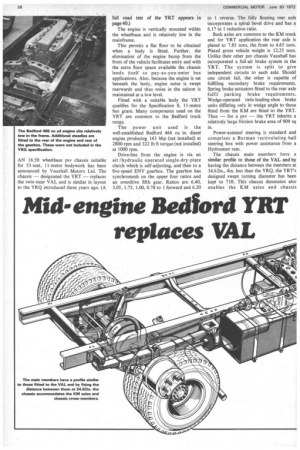Mid-engine Bedford YET
Page 40

Page 41

If you've noticed an error in this article please click here to report it so we can fix it.
replaces VAL
AN 18.5ft wheelbase psv chassis suitable for 53-seat, 11-metre bodywork has been announced by Vauxhall Motors Ltd. The chassis — designated the YRT — replaces the twin-steer VAL and is similar in layout to the YRQ introduced three years ago. (A
full road test of the YRT appears in page 40.)
The engine is vertically mounted within the wheelbase and is relatively low in the mainframe.
This permits a flat floor to be obtained when a body is fitted. Further, the elimination of the engine hump from the front of the vehicle facilitates entry and with the extra floor space available the chassis lends itself to pay-as-you-enter bus applications. Also, because the engine is set beneath the body, engine noise is swept rearwards and thus noise in the saloon is maintained at a low level.
Fitted with a suitable body the YRT qualifies for the Specification 8, 11-metre bus grant. Many components used on the YRT are common to the Bedford truck range.
The power unit used is the well-established Bedford 466 cu in. diesel engine producing 143 bhp (net installed) at 2800 rpm and 322 lb ft torque (net installed) at 1000 rpm.
Drive-line from the engine is via an air /hydraulic operated single-dry-plate clutch which is self-adjusting, and then to a five-speed ENV gearbox. The gearbox has synchromesh on the upper four ratios and an overdrive fifth gear. Ratios are 6.40, 3.05, 1.75, 1.00, 0.78 to 1 forward and 6.30
to I reverse. The fully floating rear axle incorporates a spiral bevel drive and has a 6.17 to I reduction ratio.
Both axles are common to the KM truck and for YRT application the rear axle is plated to 7.85 tons, the front to 4.65 tons. Plated gross vehicle weight is 12.25 tons. Unlike their other psv chassis Vauxhall has incorporated a full-air brake system in the YRT. The system is split to give independent circuits to each axle. Should one circuit fail, the other is capable of fulfilling secondary brake requirements. Spring brake actuators fitted to the rear axle fulfil parking brake requirements. Wedge-operated twin-leading-shoe brake units differing only in wedge angle to those fitted from the KM are fitted to the YRT. Thus — for a psv — the YRT inherits a relatively large friction brake area of 909 sq in.
Power-assisted steering is standard and comprises a Burman recirculating-ball steering box with power assistance from a Hydrosteer ram.
The chassis main members have a similar profile to those of the VAL and by having the distance between the members at 34.62in., 4in. less than the YRQ, the YRT's designed swept turning diameter has been kept to 71ft. This chassis dimension also enables the KM axles and chassis cross-members to be more easily accommodated in chassis construction.
Vauxhall has not adopted the gearchange linkage of the YRQ. Instead an ENV gearshift operates on tubular rods that transmit gear lever movements, via universal joints, to the selector unit mounted on the upper face of the box.
The suspension comprises springs — 67in. long by 3in. wide — specially designed for the mid-engine chassis; the front units have five leaves, the rear 10 and capacities are 52001b and 8750lb respectively. Heavy-duty dampers at each axle complete the package.
Mourning the engine amidships enables good ride characteristics to be obtained in the fully laden and the unladen conditions. Turning to the 24V electrical system, Vauxhall now uses 12 separately fused circuits. Essential lighting is not supplied through a common fuse, so it is unlikely that the vehicle will be plunged into sudden darkness.
The recommended retail price of the chassis including standard 9.00-20.00 radial tyres, spare wheel tyre and tube and instruments is £3250.




























































































